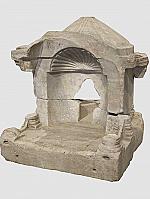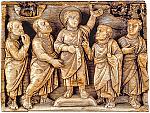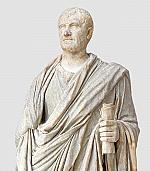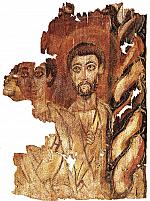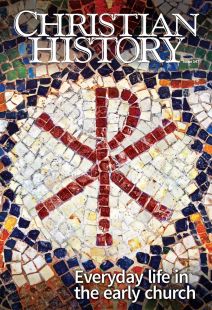The way of life
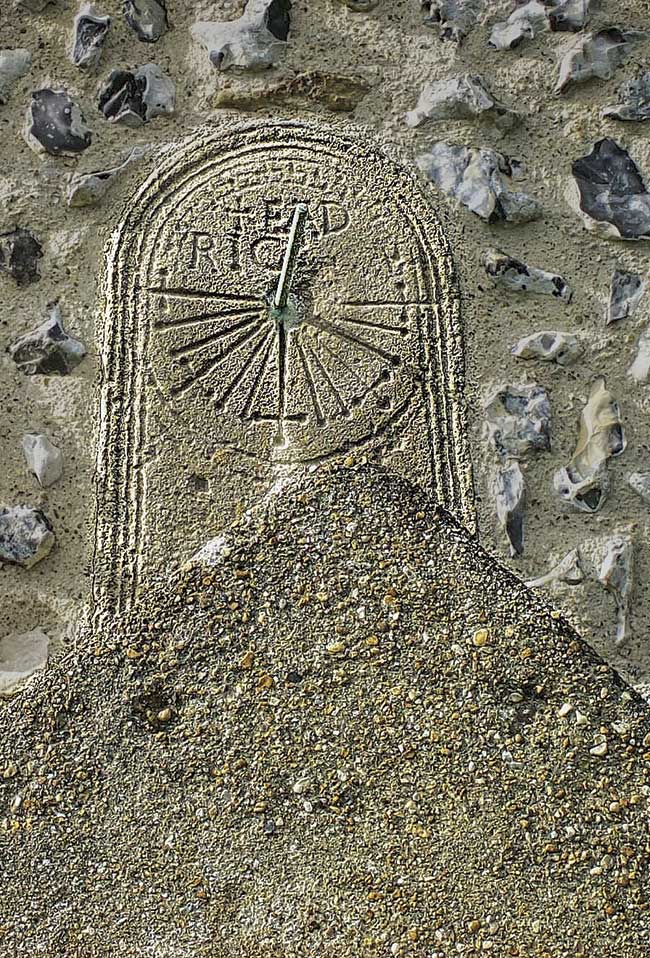
[Mass dial at St Andrew’s parish church, Bishopstone, East Sussex—Poliphilo / [CC0] Wikimedia]
Invariably when we try to imagine, let alone comprehend, the spiritual life of “ordinary Christians” in the early churches, we are faced with few direct or autobiographical accounts of their experience—unlike Christians today who compose personal spiritual journals, “prayer lists,” and the like. Trying to reconstruct early Christians’ spiritual formation and practices of prayer, we are largely forced to read into the foreground of writings that both encouraged their spiritual regimens and held them to standards they might or might not have been living up to.
A fork in the road
In the late first and second centuries, much literature, especially the “Apostolic Fathers” (1 Clement, 2 Clement, the Letters of Ignatius of Antioch, Polycarp of Smyrna’s Letter to the Philippians, the Martyrdom of Polycarp, the Didache, the Epistle of Barnabas, the Shepherd of Hermas, the Epistle to Diognetus, and Fragments of Papias) built on traditions of catechesis (teaching) and paraenesis (exhortation) in the New Testament itself when they spoke of the basics and uniqueness of the Christian way of life. Individuals’ personal piety was intrinsically and crucially bound up with that of the full community.
Often these works depict the Christian community as one of broad-based asceticism. The integrity of the church depended on members’ commitments to its distinctive practices, beginning with repentance in all its forms—contrition for sin, submission to baptism, fasting, praying, and resolving to live virtuously. Believers faced an existential fork in the road, having to choose between the “way of life (light)” and the “way of death (darkness)” (as both the Didache and the Epistle of Barnabas, from late in the first century and early in the second, explain).
Indeed modern Christians are often taken aback by the severity of the demand for penitence observed in primitive churches. There, as the Shepherd of Hermas (second century) and other sources tell us, baptism was the pivotal medium of remission of sins, after which believers could be granted only one more chance—a “second repentance”—to enjoy the grace of divine pardon. This severity relaxed over time as realism caught up with church leaders. Increasingly they saw the sacrament of baptism as communicating a grace of forgiveness that believers would need over an entire lifetime, along with an enduring penitence.
While the Apostolic Fathers and other early authors were quite clear that the Christian life entails obedience to specific commandments or mandates, such obedience needed forming and framing, lest it become purely a matter of fulfilling requirements. Already in Judaism observance of the Torah entailed actions designed to reform and renew believers, not just to assure their status as righteous. Framing Christian obedience in terms of the imitation of Christ’s own obedience to the Father, or of the radical witness of saints and martyrs, gave repentance and obedience a larger context in holistic Christian character formation.
Christianity emerged in a Roman Empire already having its own public standards of prayer. Invocation, incantation, and theurgy (rituals that ask for the presence of a deity) were familiar elements in pagan culture and civic religion; they were considered indispensable for bidding the gods (or the one high God) to secure and ensure the flourishing of society.
While we can find instances in ancient Greece and Rome of prayer being offered to a god along more pious or devotional lines, such as the Stoic philosopher Cleanthes’s famous Hymn to Zeus (third century BC), this was hardly the public norm. Early Christians viewed pagan prayer as shamefully utilitarian. Authentic prayer entailed personal and communal devotion to a God whose love and mercy could never depend on contrived human mechanisms, religious or otherwise. Private and public prayer, encouraged as both communication and communion with God, thus became a mainstay of early Christian piety at all levels.
Daily prayer and praise
Earliest Christianity, beginning with the ministry of Jesus himself, took inspiration from Jewish practices of prayer at specific times throughout the day (preferably three as in Daniel 6:10), as well as blessings at meals. While Jews certainly could recite prayers in private, the synagogue became the hub for observing daily times of prayer, and it also hosted the Sabbath liturgy. Acts details how Jewish Christians, including apostles, continued in daily times of prayer (Acts 3:1; 10:9, 30; 16:25; 22:17) and in gatherings to pray inside and inevitably in other venues (Acts 1:14; 2:42; 6:4; 12:12; 16:13, 16). In addition to this, believers lifted prayers up for special needs and occasions (healings, ordinations, etc.).
How much and how often early Christians actually prayed is difficult to track, since we cannot assume that leaders’ encouragement automatically translated into large numbers of Christians following through. By the fourth century, even if bishops recommended the “daily office” (from officium, “duty”) of prayer or “liturgy of the hours” for all Christians, the difficulty of coming together in the church to sustain this discipline proved prohibitive—especially as the daily office of prayer became more, not less, ritualized and liturgical in both East and West, consuming ever more time.
This so-called cathedral office of prayer remained intact as a way of enjoining all Christians to uphold Paul’s admonition to “pray without ceasing” (1 Thess. 5:17). To this day various church traditions celebrate at least morning prayer (matins) and evening prayer (evensong) with an open invitation for all to participate. But it was monasticism, from the fourth century on, that took the daily office to new heights. Monks made it the liturgical backbone of the Christian day, with some monastic orders expanding the discipline to eight daily times of prayer, distinguished also by the extensive integration of the Psalms.
The cathedral and monastic offices of prayer in turn grew up together and respectively amplified the New Testament’s emphasis on daily prayer as pivotal to prepare the faithful for Christ’s second coming. The monastic office, in particular, reflected this urgency of Christians living in the shadow of God’s imminent judgment.
The Didache mandates that Christians should pray the Lord’s Prayer three times a day. While we cannot confirm that this became general practice, it does indicate the unique prestige of the Lord’s Prayer—eventually recited in private, at baptisms, and in the Eucharistic liturgy. Extemporaneous or spontaneous prayers did occur in the early church, as Tertullian (c. 155–c. 220) mentioned in On Prayer, but Christians’ private prayers were heavily shaped by biblical precedents and by corporate worship. The Lord’s Prayer served as a living link between private and liturgical prayer. As Jesus’s own outline of believers’ prayer, how could it have been otherwise?
Several early Christian luminaries therefore wrote commentaries or sermons on the Lord’s Prayer, including Tertullian, Cyprian (c. 210–c. 259), Origen (c. 185–c. 253), Gregory of Nyssa (c. 335–395), Cyril of Jerusalem (c. 313–386), Augustine (254–430), and Maximus the Confessor (c. 580–662), drawing out the deeper meanings of each clause for the faithful. The prayer also proved a vital component in pre- and postbaptismal catechesis. Expositors tied doctrinal understanding of God to the constant need to invoke and petition God amid the relentless challenges of Christian life in an uncertain and often hostile world.
Ultimately, too, the Lord’s Prayer became a virtual sacrament, a verbal means of grace, in its private and corporate recitation. Ministering in third-century Carthage, to a church all too familiar with the specter of imperial persecution, Cyprian eloquently elicited this principle in On the Lord’s Prayer (252):
Let us then, beloved brothers and sisters, pray as God our Teacher has taught us. . . . Let the Father recognize the words of his own Son when we recite our prayer, and let him who already dwells deep within us also indwell our voice. And seeing as we have [Christ] as Advocate with the Father for our sins (1 John 2:1), let us, when as sinners we entreat God for our sins, utter the words of our Advocate. For since he says, that whatsoever we shall ask of the Father in his name, he will give us (John 16:23), how much more effectively do we obtain what we ask in Christ’s name if we ask for it with his own prayer?
How then should we pray?
Not surprisingly, given that it pervaded all aspects of Christian existence, leaders continued throughout antiquity to provide instruction on the protocols and content of prayer, as various issues arose regarding its appropriate practice.
Tertullian addressed bodily posture (kneeling, sitting, raising hands), whether hands need to be washed for prayer, women’s and men’s apparel in prayer, places and times of prayer, whether Psalms should be attached to prayers, and more. Origen took up some of the same issues, including the vexing problem of flushing away vain thoughts, distractions, and perturbing passions from one’s mental and spiritual focus in prayer—a matter addressed in detail by later monastic theologians such as Evagrius Ponticus and John Cassian.
Another perennial challenge was how to fulfill 1 Thessalonians 5:17, and the daily office was long put forward as the reasonable way most Christians could do so. Monks naturally took the precept to pray without ceasing with additional seriousness. In the fifth-century Sayings of the Desert Fathers and Mothers, Abba Lucius told some inquirers that he prayed without ceasing while engaged in daily manual labor by sitting down with God and repeating the words, “God, have mercy on me, according to your great goodness and according to the multitude of mercies, save me from my sins.” And while eating or sleeping, Lucius reported that he simply paid someone outside his cell to pray for him.
Origen, in his rich treatise On Prayer (c. 200), dwelled at length on how prayer operates within the economy of God’s providence (the issue of “answered” prayer), and he offered a veritable religious psychology of the subject. For Origen prayer fit into the larger scheme of training the Christian soul’s desires and aspirations through the help of the ever-present divine Logos (Word). As High Priest before the Father (Heb. 2:17; 3:1; 4:14, etc.), the Logos mediates and advocates for the faithful: “He prays for those who pray and appeals along with those who appeal.”
For this reason Origen discouraged prayers directly to the Logos (Christ the Word), insisting that believers lift up their prayers to the Father through the Logos. Gregory of Nyssa in the late-fourth-century Homily 1 on the Lord’s Prayer insisted on avoiding “heathen babble” (battalogia, as in Matt. 6:7) and petitions that are frivolous and aim low, rather than aiming to conform the soul to God’s own desire.
A gift to the church
Naturally the problem of what makes prayer “effective” did not subside. Already when the writer of James posited that “the prayer of the righteous is powerful and effective” (James 5:16), the presumption was not that just the right words were all that was needed to achieve the desired effect.
Prayer is to no avail if “the righteous” are not open to God forming and maturing them through experience of suffering and cultivation of patience. Indeed many an early Christian interpreter of the effectiveness of prayer could have sympathized with the later famous axiom of both Kierkegaard and C. S. Lewis that prayer does not change God but changes the person who does the praying.
Maximus the Confessor commented on James 5:16 in Questions and Responses to Thalassius:
The prayers of the righteous are made effective first by combining their supplications with faithfulness to God’s commandments and virtues, and second by praying for the unrighteous and converting them to their own life of prayer and Christian living.
Very early on the church reclaimed the most basic of biblical prayers, repeated by needy petitioners in various situations but finding especially poignant expression in the parable of the publican, when he exclaimed, “God have mercy on me, a sinner” (Luke 18:13). Kyrie eleison (Lord, have mercy) was incorporated into regular liturgical usage by the fourth century and became a mainstay of Christian worship East and West. Christian monks took this petition with even greater urgency, as the Sayings of Macarius (c. 300–391) shows:
Abba Macarius was asked, “How should one pray?” The old man said, “There is no need at all for long discourses; it is enough to stretch out one’s hands and say, ‘Lord, as you will, and as you know, have mercy.’ And if the conflict grows fiercer say, ‘Lord, help!’”
Over time Byzantine monks in the Hesychast (“stillness” prayer) tradition added a strongly Christocentric focus to the prayer, invoking the name of Jesus himself rather than simply “Lord,” and calling on him deep from within the heart, with rhythmic continuity that brought the body and breathing into play.
Whether it be the familiar Kyrie eleison, or the Jesus Prayer promoted in monastic communities, this humble and penitent cry for mercy entered the broader Christian tradition as the believer’s prayer from spiritual ground zero. It was, and is, a gift of the early church to the ecumenical church today, a true anchor of Christian religious life. CH
By Paul M. Blowers
[Christian History originally published this article in Christian History Issue #147 in 2023]
Paul M. Blowers is Dean E. Walker Professor of Church History at Milligan University and has authored, edited, and translated numerous books on the early church.Next articles
Serving the true Lord and God
Why Christians presented such a huge challenge to the Roman state
George Kalantzis“This superstition”
Pliny, Roman governor of Bithynia in the early second century, asks for advice on how to deal with the Christian movement
PlinyThe emperor and the desert
Christian commitment to asceticism grew in a newly legalized faith
Kate CooperSupport us
Christian History Institute (CHI) is a non-profit Pennsylvania corporation founded in 1982. Your donations support the continuation of this ministry
Donate



